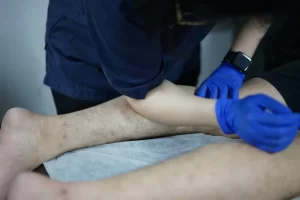The advent of 3D printing technology has revolutionized the medical sector, especially in the customization of osteoinductive implants. Osteoinductivity refers to the ability of a material used in implants to aid in bone growth by encouraging surrounding progenitor cells to differentiate into osteoblasts.
This capability is particularly significant in orthopedics, where the integration of an implant with native bone is crucial for the success of surgical procedures such as spinal fusion, bone repair, and joint replacement.
Key Takeaways
- 3D printing has enabled the customization of implants, improving not only the physical integration of these medical devices but also their biological function.
- As the technology evolves, the future of customized osteoinductive implants has the potential to significantly improve patient outcomes in orthopedic and other bone-related surgeries.
Table of Contents
Advancements in Implant Design
3D printing, also known as additive manufacturing, has enabled the production of implants that are highly customized to the patient’s anatomy. This customization is vital for several reasons.
Firstly, it increases the likelihood of the implant fitting perfectly with the existing bone structure. This perfect symmetry significantly improves surgical outcomes and reduces the risk of implant rejection.
Secondly, customized implants can be designed to mimic the mechanical properties of natural bone. This supports the even distribution of stress across the bone and implant, reducing the risk of implant failure.
Enhancing Osteoinductivity With Precision
One of the most critical advantages of 3D printing in the context of osteoinductive implants is the ability to manipulate the surface architecture of the implants at a microscopic level.
Research has shown that specific patterns and textures on the surface of an implant can enhance osteoinductivity. For example, certain micro-scale geometries can stimulate better cell attachment, proliferation, and differentiation, which are essential for bone regeneration.
3D printing allows for the creation of complex geometries that were previously impossible or impractical with traditional manufacturing techniques. This capability enables the production of implants that not only fit better but also actively facilitate the bone healing process.
Case Studies Highlighting the Impact of 3D Printing in Osteoinductive Implant Customization
Case Study 1: Spinal Implants
In one notable instance, a series of patients requiring spinal fusion surgery received 3D-printed titanium implants designed to replace degenerated vertebral discs. These implants were customized to fit the unique contours of each patient’s spinal anatomy.
The surfaces of these implants were engineered to maximize osteoinductivity, featuring textures that encouraged bone growth. Follow-up studies showed that patients had quicker bone integration and faster recovery times compared to those who received standard implants.
Case Study 2: Cranial Reconstruction
Another case involved a patient needing cranial reconstruction after a severe injury. A 3D-printed implant was used, designed not only for aesthetic restoration but also for functional integration.
The implant’s porous structure was tailored to encourage vascularization and osteoinduction. Over time, the implant successfully integrated with the surrounding skull bone, demonstrating the implant’s osteoinductivity and the potential of 3D printing to impact critical reconstructive surgeries positively.
Best Practices in Implementing 3D Printing for Osteoinductive Implants
Collaborative Design Processes
Engaging a multidisciplinary team including surgeons, engineers, and material scientists in the implant design process can optimize the use of 3D printing technology for osteoinductive applications. This collaboration ensures that the implants are not only anatomically accurate but also functionally effective.Material Selection
The choice of material is crucial in maximizing the implant’s osteoinductive properties. Materials like titanium and certain biocompatible polymers have been shown to be effective. Innovations in material science, such as the development of composite materials or the integration of bioactive substances, can further enhance osteoinductivity.Regulatory Compliance
As with all medical devices, 3D-printed osteoinductive implants must adhere to strict regulatory standards. Manufacturers need to ensure that their products are consistently safe and effective. This includes rigorous testing for biocompatibility, structural integrity, and osteoinductive potential before clinical use.Partner With IBEX for Quality Orthopedic Preclinical Research
Enhance the osteoinductivity and safety of your orthopedic innovations with IBEX Research. Our dedicated team will rigorously evaluate and refine your medical devices, ensuring they meet the highest standards of efficacy and regulatory compliance.
Contact us today to discover how we can support your journey toward transforming orthopedic treatment.






